You are browsing
BOOKS
VistaBooks
history reprint
from VistaBooks
VISTABOOKS HISTORY REPRINT--
"Kaibeto Memories"
(in stock: for quantity orders, go to vistabooks.com):
also available on ebay and ebid
 KAIBETO MEMORIES: a trader's daughter remembers growing up
KAIBETO MEMORIES: a trader's daughter remembers growing up
on the Navajo Reservation at Kaibeto Trading Post
in remote northern Arizona 1936-1960.
 by Elizabeth Anne Jones Dewveall.
by Elizabeth Anne Jones Dewveall.
Even today Kaibeto does not appear as a place on many modern maps. When Elizabeth Anne was growing up in this remote desert region of northern Arizona roads were still evolving from dirt tracks and passage was not infrequently blocked by drifting sand, unpredictable floods in otherwise dry washes, or snowstorms, with pavement dozens and dozens of miles away in all directions and little development of any kind along the routes. The trading post, however, had already been a hub for supplies for the local population for 22 years when Elizabeth Anne started her life there as daughter of traders Ralph and Julia Jones. Elizabeth Anne grew up as an only child at this remote outpost, with Navajo Indian children as playmates and an occasional visit by relatives from distant places. In time she would learn some Navajo words, how to trade the post's goods in an economy with little cash, and something of a culture not her own. The post took in hides, wool, silver and turquoise jewelry, woven blankets as items of exchange and often relied on a pawn system, storing native treasures as collateral. Much of her account, however, is of stories of the native people who came to the post and of their joys, trials, and tribulations as they managed their lives with ingenuity and perseverance. The stories Elizabeth Anne tells provide a glimpse of life at this trading post, of which little has been written before, and by extension of what life might have been like at the many other trading post throughout the West that linked populations through an economic setting. 120 pages, illustrations, map.
"Intriguing", as one museum curator called Eiizabeth Anne's account.
Another reviewer noted the account's "such historical merit and deep personal interest."
And “Her life story is fascinating and she was a witness to an important aspect of US-Native history…the memoir should be published” from one university editor.
And this from another “Elizabeth Anne experienced an unusual and special youth that, beyond an individual life, can reveal much about Kaibeto and Navajo life in the mid-twentieth century…”
Paper edition: Inventory = available in quanity from VistaBooks.
ISBN: 978-0-8946-103-1.Order #: VIST0103 paper$14.95.
Paper edition also available at Amazon.com, eBay.com, ebid.net, IngramSpark.com.
Cloth edition: Inventory = available in quantity from VistaBooks.
ISBN: 978-0-8946-105-5.Order #: VIST0105 cloth $25.00.
Cloth edition also available at Amazon.com and eBay.com.
Electronic edition available from Amazon.com: ISBN: 978-0-89646-104-8.
Sample pages and illustrations from Kaibeto Memories -- a trader's daugher remembers growing up on the Navajo Reservation at Kaibeto Trading Post in remote nothern Arizona 1936-1960
FOREWORD
by Bob and Bill Jones, Elizabeth Anne's cousins
Our cousin Elizabeth Anne spent her early years on the Navajo Indian Reservation at Kaibeto Trading Post. She was the daughter of the trader there. Her trader-father, Ralph Jones, and her mother, Julia, operated this supplier of white-man’s goods to local Indians at a time when there was no other source for supplies in that barren land. Bluffs, mesas, and sandy desert were the landscape around this place, then among the most isolated in the United states with something like seventy-five miles to the nearest railroad track over rut roads.
For the Natives, producing a living on this land required ingenuity and perseverance, and the trading post provided some of what was needed to make life a bit easier.
Elizabeth Anne’s time at the post was from her birth in 1936 until the early 1960s. Her playmates were often Native children. When Elizabeth Anne reached school age she lived during school sessions in Winslow with her Aunt Zada, Uncle John, and their two daughters so she could attend schools there.” But when at the trading post during school breaks and summer vacations, she, too, became a trader, helping with sales and operation of the post. She thus had a youth that was unusual for a girl in America and which led to experiences involving interactions among two cultures.
Several of us in the family have prodded Elizabeth Anne to “write a book” about her Kaibeto experiences, but only recently during COVID downtime did she begin to jot down her memories as they came to her day by day. She posted notes on Facebook as she produced one little story after another to share with friends and family and to record the contribution her parents made to the trading post’s history. Finally, Elizabeth Anne has agreed to allow her Kaibeto memories to be gathered into book, and many of us are grateful.
Though Elizabeth Anne’s wider family includes writers of various kinds, many of us feel she is the best writer among us. Her prose is direct, clear, and has a nice bounce to it. One feels immediately present in her scenes, and her sentences often seem to have a smile on their faces. Sometimes she brings forth a genuine belly laugh without even trying.
Now others can enjoy our cousin’s lively, down-home accounts of childhood and teenage years in that remote spot in northern Arizona. The tales, in fact, include a time when Elizabeth Anne and her husband Bob managed Kaibeto Trading Post just as her mother and father did when she was a young girl there. It’s hard to imagine anyone now alive knows more of the Kaibeto trading operation than Elizabeth Anne does.
In, with, and under some of Elizabeth Anne’s memories, we have specific, firsthand instances of respect, friendship, and even deep caring between the trader’s family and their customers. And occasionally there is a hint of resentment toward white culture when it seemed not to value Navajo ways. So, along with her delightful telling about her life “on the Rez” as she calls it, Elizabeth Anne has given historians and cultural anthropologists a primary source of information and insight into the ongoing interactions between whites and native peoples in America.
Our cousin wants us to keep in mind that her stories do not portray Navajo ways today. She suspects they now use credit cards or smart phones to pay for things, and she knows many in the younger generation who have been to fine schools and gone on to college and the professions. “The old ways,” she says, “are mostly gone.”
Readers also do well to be aware that Elizabeth Anne’s memories do not proceed in chronological order from her earliest days onward but are set down as she remembers them during those recent weeks of intense COVID concern. Toward the end, she gives dates for the day the memory was written down. With but few minor changes, we have remained faithful to what Elizabeth Anne wrote.
In putting this book together, we are grateful for help and encouragement from many family members, and we make special mention of the following: Pete Langford who saw these writings on Facebook and with Katherine Lopez copied them off and saved them, Robin Zagarins, for preserving pictures of little Elizabeth Anne in Navajo dress and of Trader Ralph at the road sign, Katie Langford for journalistic advice, Richard and Teddy Jones for searching out old maps of the Kaibeto area, and, of course, Elizabeth Anne herself for Kaibeto pictures and for turning her talented writer’s hand to the task of setting down her memories for us.
When we were in our early teens, the two of us cousins had a great adventure living with Ralph, Julia, and Elizabeth Anne at Kaibeto for a week or so. We rode Indian ponies, watched weavers at work, saw the dog get struck by a rattlesnake (the dog lived), pumped gas, and went trembling into the dark cave to bring in a fresh supply of “total chosie,“ which is what we thought Navajos called soda pop. So it is our special pleasure to help make a book out of our cousin’s captivating stories from her early life. We hope you, too, will enjoy them, learn from them, and gain a deeper appreciation for the life Elizabeth Anne and her parents lived out there in Kaibeto. May we also come to understand something of the Navajo culture and the people who have lived it in their wide, barren, and beautiful land.
--Bob Jones and Bill Jones (or Bobby and Billy as we were called when we stayed at Kaibeto Trading Post in the 1940s.
One of Elizabeth Anne's stories:
Editor’s Note: Each memory Elizabeth Anne recorded during her COVID down-time is separated by a space from the next. They are presented in the sequence she remembered them but not necessarily in the sequence in which the events occurred. Her narrative is as she is reporting to FaceBook friends, copied here in that form as first-person recorded history:
"Catching up on newspaper reading today and feeling sad about the plight of the Navajo people during this pandemic. When my parents were traders on the Rez all those years ago, most Navajo families hauled their water, making it an extremely precious commodity. For about thirty percent of the population this is still true today. A fifty-gallon barrel of water for a week’s supply does not make for the recommended frequent hand washing.
People tell me I should write a book about the more than twenty-five years my folks manned that desolate, but beautiful trading post. When you arrived at Kaibeto, you had to leave by the same road you came, for it was truly the end of the line. We had few visitors and those we didn’t know, especially if they were Anglo, were looked at with suspicion. During those days, more than one trading post went up in flames along with their proprietors. It was never, ever a Navajo who caused such harm. So, yes, I do have enough trading post yarns to outlast this pandemic and tomorrow I will attempt to bring you one featuring my inimitable father. For today I would ask for your prayers for these dear people who were so good to our family for so many years.
It’s one of those days with a multitude of interruptions, so the story I promised yesterday will be tomorrow’s tale. Never fear, I have just finished listening to the latest political hoopla surrounding our current situation and it reminded me of a bit of political collusion on the reservation more than a half century ago. After the Suffragettes finished their worthy work, there was still one group in our nation who were denied the privilege of voting. This travesty was eventually corrected, and Native Americans were allowed to go to the polls. Like the rest of us, these tribal citizens first had to register to vote. And in order to register there had to be a registrar. Each trading post had a suitable..." (and here the story gets more interesting)
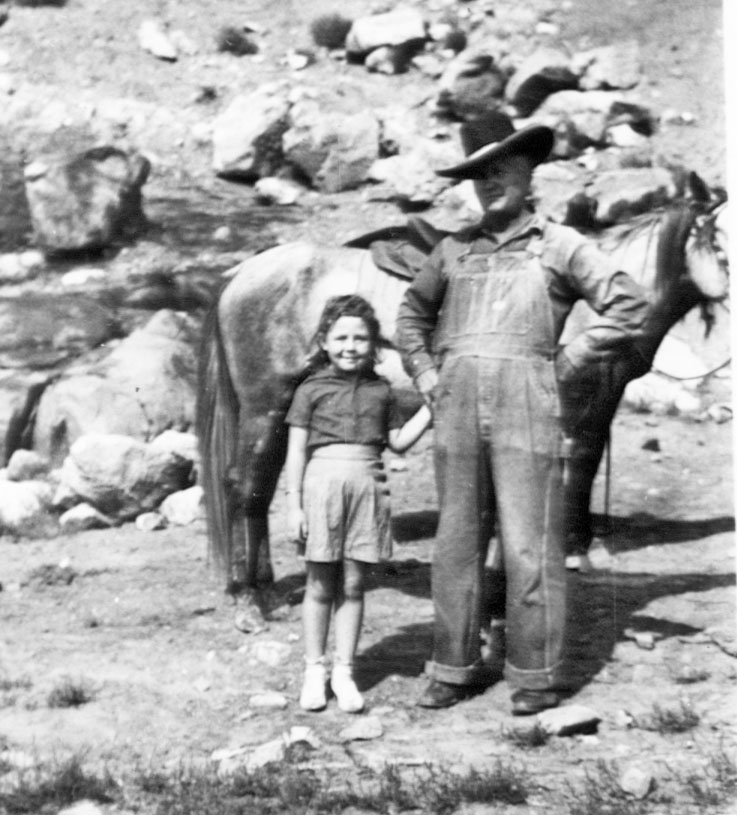 Elizabeth Anne holding Daddy’s hand,
Elizabeth Anne holding Daddy’s hand,
while Ralph
is in his typical "trader's uniform”
for being merchant, warehouseman, mechanic, and more.
1943.
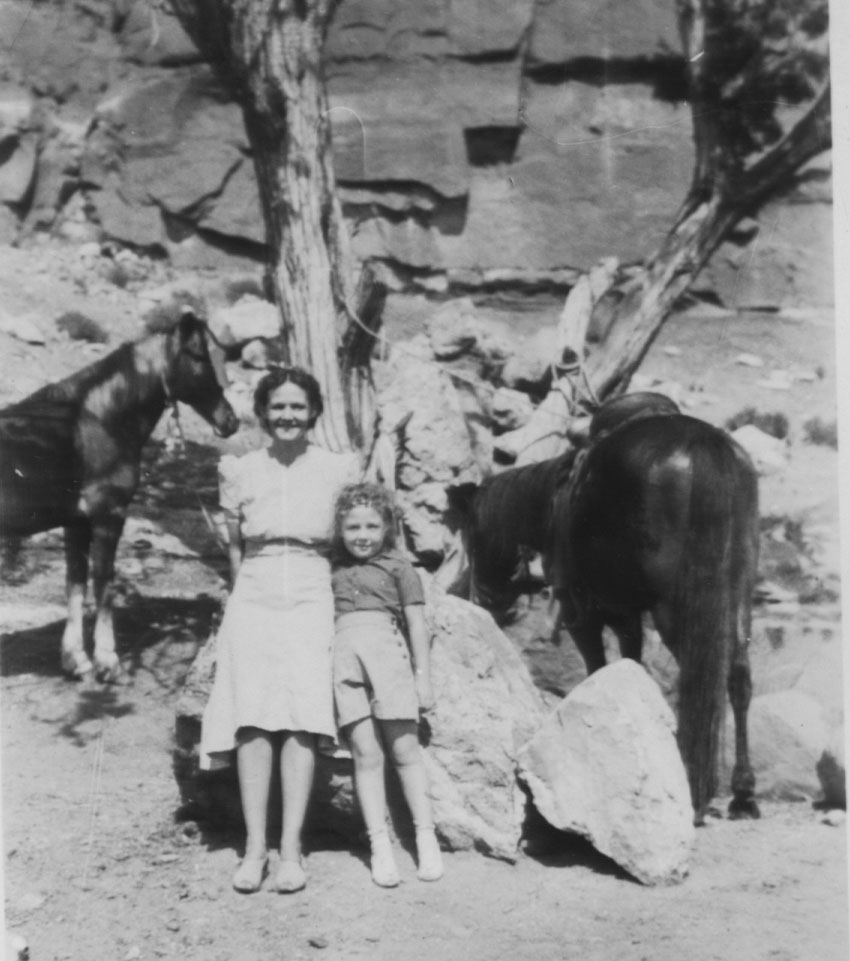
Elizabeth Anne and mother Julia
in "trader's uniform"
for trading in the store. circa 1943.
Another of Elizabeth Anne's stories:Watermelons!
"One of the best parts of a trading post summer was the
watermelon truck. The Hopi tribe grew many varieties of fruit in impossibly dry
and sandy gardens, but their watermelons were the sweetest of all their
produce. We never knew when Mark (can't recall his last name) was going to come
rumbling up the road with a truck load of these luscious offerings, but there
was always enough cash on hand to pay his asking price. By the time the truck
at least a hundred.
We sold the melons whole or cut in half, but few survived to be carried to
pickup or wagon. Instead, time stopped as, with juices
running down chins and dripping off elbows, we all slurped and chewed down to
the last suggestion of pink by the rind.
Daddy sliced his piece in a big round right out of the middle, added salt
(yuk), then used his pocketknife to snare each bite. He would hand me a huge
wedge which I ate without benefit of utensils while sitting atop the fence with
everyone else who could crowd into the shade provided by our big cotton wood
trees. We may have been a group divided by language and culture, but on watermelon
day we were supremely united by taste buds and flavor. Mother, who always got
sick when she ate watermelon, was left alone to tend the store and so missed this wonderful communion of like souls. I don't think she ever
had any customers."
Map of Kaibito region, norheastern Arizona. 2010.
Courtesy Arizona Office of Tourism.
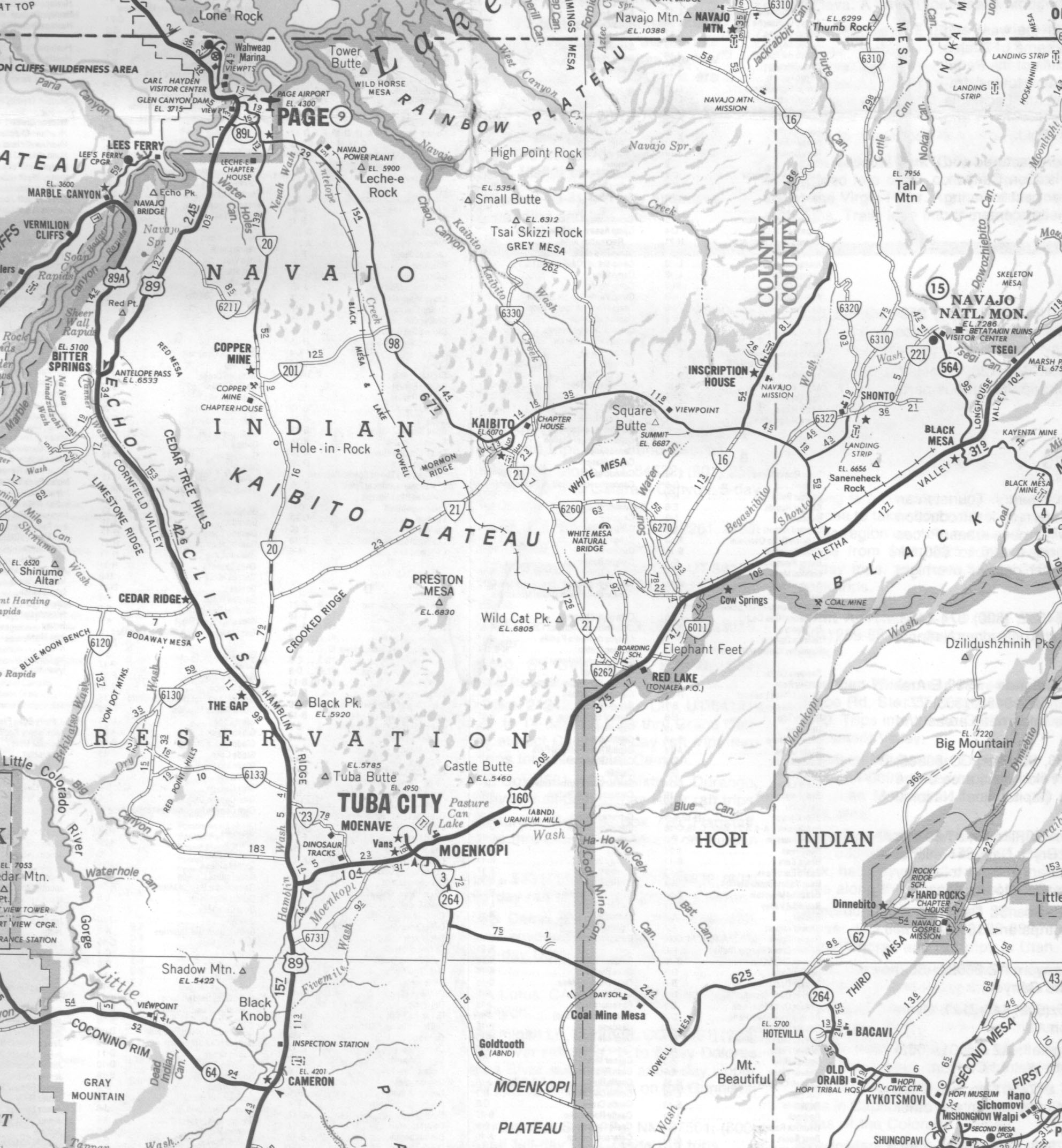
ILLUSTRATIONS
1.
Kaibeto Trading Post
2.
Elizabeth Anne holding Daddy’s hand
3.
Elizabeth Anne and mother Julia
4.
Author Elizabeth Anne Dewveall Jones has been playing the flute
5.
Ralph Jones with his wife Julia
6.
Sacks of wool stacked 4+ high
7.
Trader Ralph Jones posing at a road sign
8.
Elizabeth Anne in her Navajo dress
9.
A trader family in “going to town” clothes
10.
Julia Jones, as a young married in 1934
11.
Mamaw, Ralph’s mother, with Elizabeth Anne
12.
Interior of Kaibeto Trading Post
13.
Hitching post beside the trading post
14.
Mother Julia has caught a fish
15.
Frenchman’s Lake
16.
Navajo workers building a stone wall as part of a dam
17.
Sheep were a mainstay in the region’s economy
18.
Elizabeth Anne had many dolls
19.
Elizabeth Anne with Natives
20.
Elizabeth Anne gives her dog a bath in a tub
21.
Group at plane at Kaibito airport
22.
A Navajo couple outside Kaibeto Trading Post, with “Little Ralph”
23.
Julia Jones astride an Indian pony
24.
Julia Jones leads a horse tour
25.
Elizabeth Anne liked horses
26.
Letter to Elizabeth Anne at school
MAPS
1.
Kai Peto Springs shows on an 1886 map of the region.Map by U.S. Geological Survey.
2.
Map of Kaibito Region. 2010. Courtesy Arizona Department of Tourism
KAIBITO/KAIBETO
"NAVAJO WORDS LIKE KAIBITO were initially not written. This may explain why different spellings got attached to different places. Not far from the trading post is a spring that has long been called Kaibito Spring and which may explain why the post was built where it was. Such springs in this region are not unlikely to have willows. From the web page of the K’ Ai’ Bii’ To’ chapter of the Navajo Nation we learn that the word “Kaibito” or “Kaibeto” derives from the old Navajo phrase that is expressed in writing as K’ Ai’ Bii’ To’. The web site also tells us this can be translated “willow in the water.”
In today’s world two spellings of Kaibito/Kaibeto are used for different features: The trading post from far back in time has been spelled Kaibeto as is the Kaibeto Indian School, but the creek that occasionally runs past these places is shown on government maps as Kaibito, as is Kaibito Spring, Kaibito Plateau, and the town of Kaibito but which today has the Kaibeto post office. In Kaibeto Memories Elizabeth Anne always uses her preferred form Kaibeto; elsewhere the separate spellings that have traditionally been applied to separate features have been used. Generally, however, such strict practice is not followed."
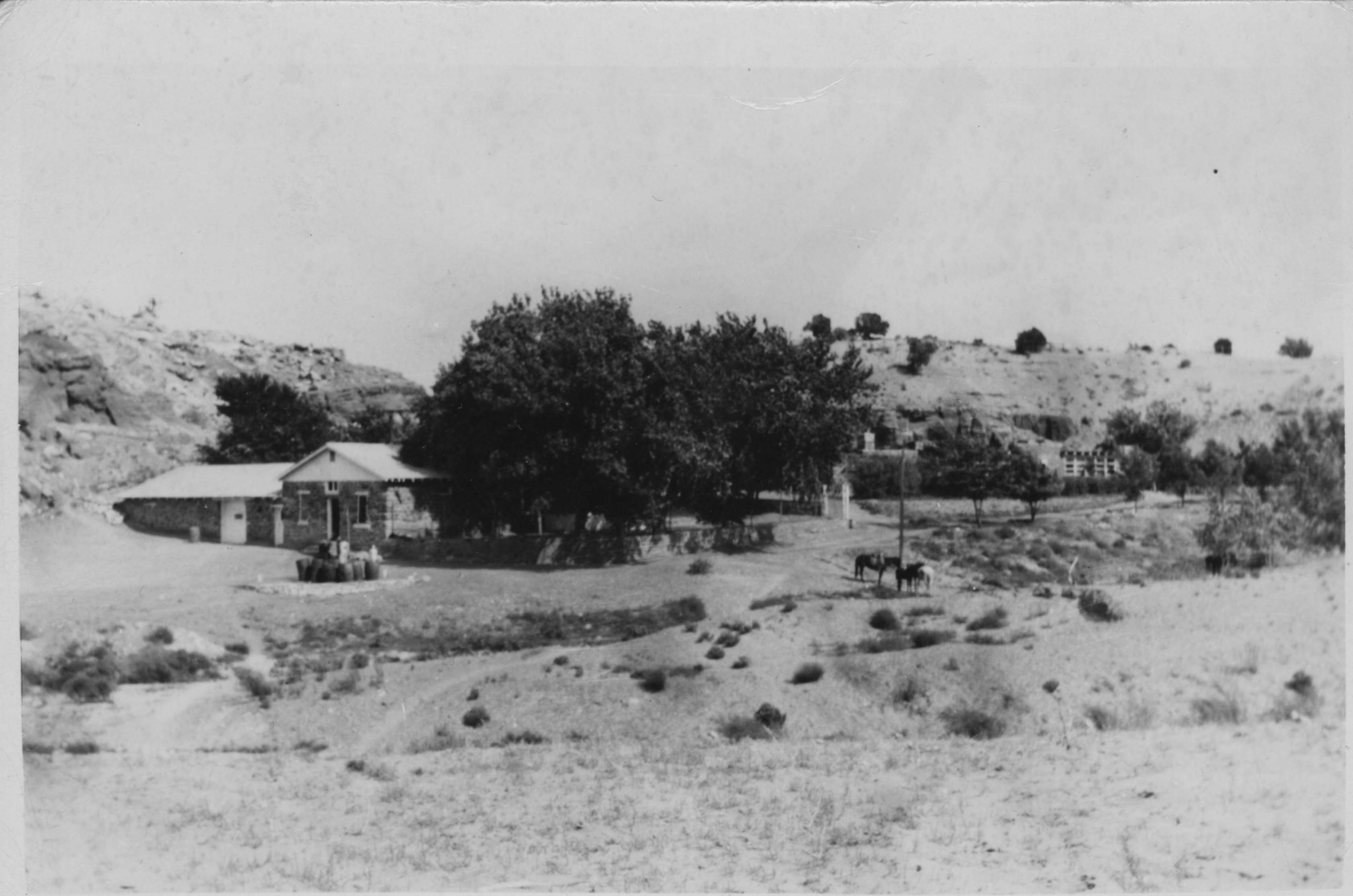
Kaibeto Trading Post. Here is where Elizabeth Anne spent much of her childhood. The house where she lived, obscured here by trees, was attached to the trading post (shown on the left). An interior doorway passed from the house to the trading area, keeping traders on-call almost constantly. The main entrance to the trading area, flanked by windows on each side, shows in the center of the more prominent building. The structure on the left is the warehouse for storing supplies and traded merchandise such as hides. This picture is a bit unusual in that it was not uncommon to see in the view here not only horses, but wagons and even a pickup. Natives might also linger, socialize, await a family member's lengthy shopping session, or play card games before or after their trading activity, sometimes all day. (Photo: August 1948).
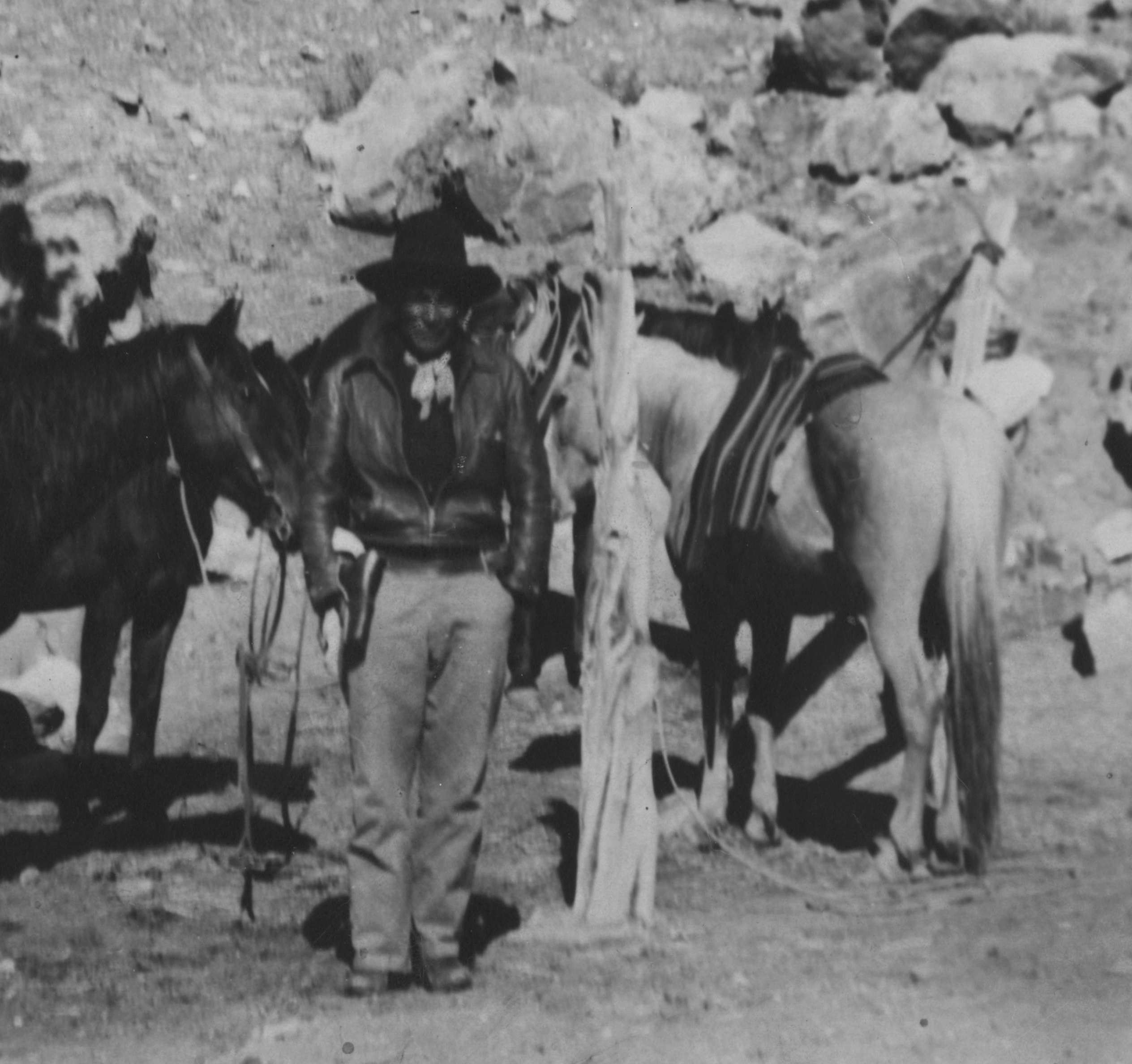
Kaibeto customer (note sidearm) at the hitching post
And another of Elizabeth Anne's stories:
"The Navajo Reservation completely surrounds the Hopi Reservation. This is not ain ideal situation for either tribe, but back when Bob and I were at Rare Metals it didn't seem to be much of an issue. The little church we attended was said to be located half on Hopi land and half on Navajo. I don't think anyone knew this for sure and certainly no one knew which side was which. We were a small and compatible group who enjoyed worshiping and fellowshipping together. It was probably July 4th of 1957 when we had a picnic on Moencopi Wash where some huge cottonwood trees provided luxuriant shade.
I was at the stage of pregnancy where I didn't care if I had a boy or a girl, I just wanted "it" out. I was weary of all the speculation and superstition of "sex telling" that went with pregnancy before the advent of ultrasounds or whatever they call them now. If you carry your baby high, it is a girl, low means a boy. Swing your wedding ring on a string and if it goes from one side to the other it is a boy, if it swings the other way a girl. Rapid heartbeat means boy, not so fast, girl. (Our doctor sort of fancied that one.) I was seated on the ground, le
aning against a tree trunk and thinking I was not going to be able to get up until my husband showed up to help.
I dozed off and then heard footsteps. When I opened my eyes, it was not Bob who stood there but a little Hopi man named Mark Quarshero. In his right hand he held a beautifully painted gourd rattle which he began shaking over my bulging middle. It didn't take long for him to tell me there was a little girl in there. He gave me the rattle for her protection, then walked away as if he had done the most normal thing in the world. SueAnne still has the rattle. I still have the sweet memory."
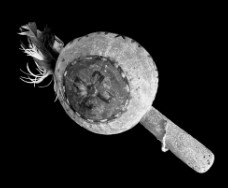
Photo of the actual rattle
More sample pages and iullustrations from Kaibeto Memories:
Ellizabelth Anne with Navajo playmates
Eliazabeth Anne at the trading post gas pump for Standard Oil ad
Frenchman's Lake, now gone
sacks of wool at trading post
Indian couple who named their children for Elizabeth Anne's trader parents as "Little Ralph" and "Little Julia".
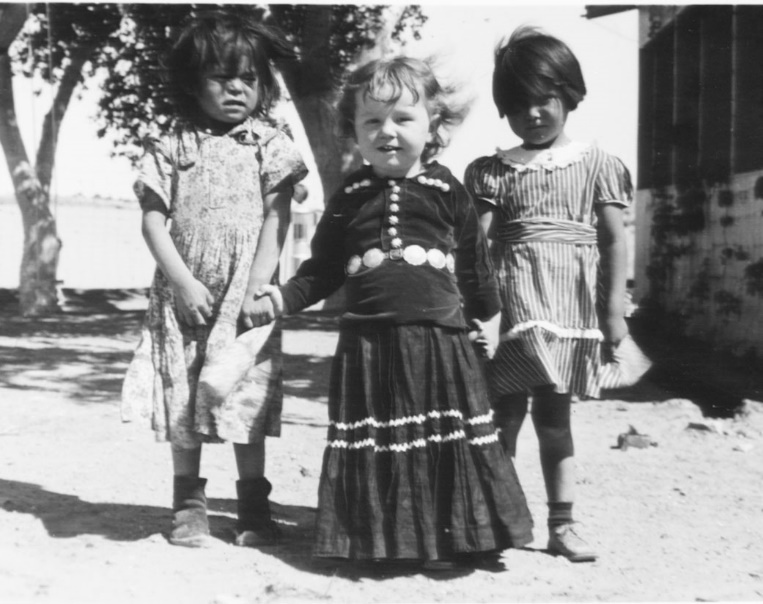
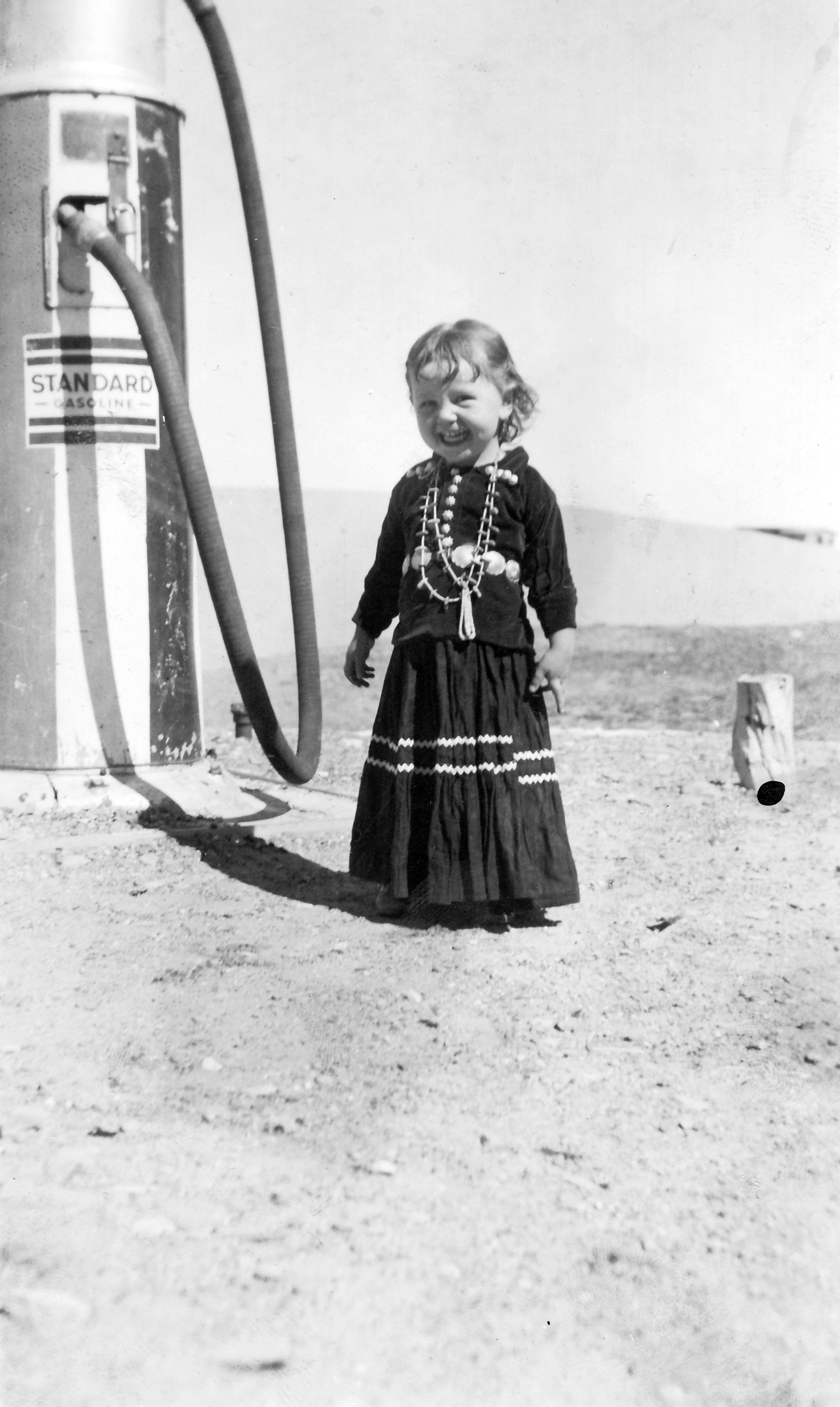
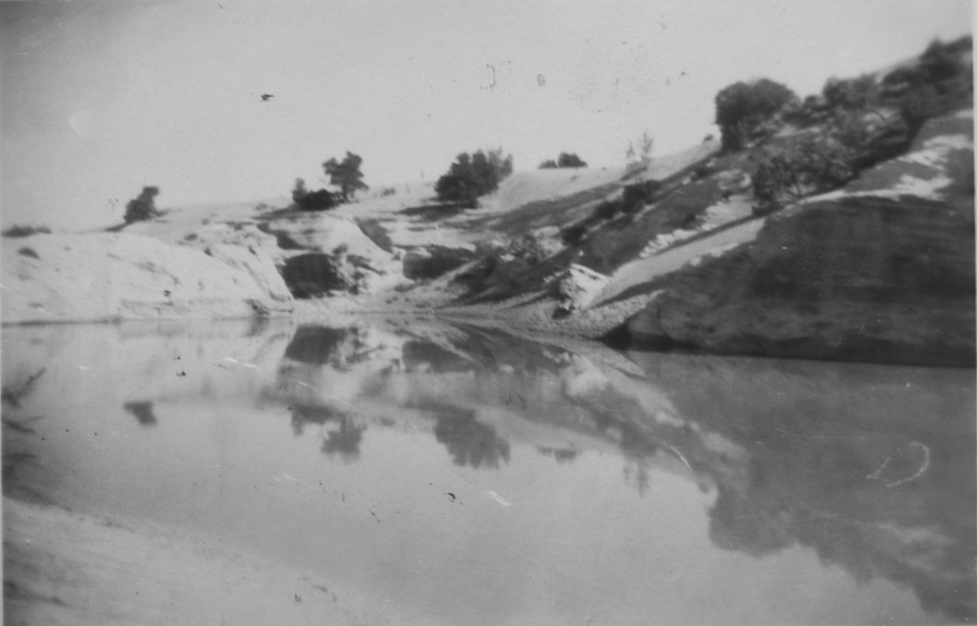
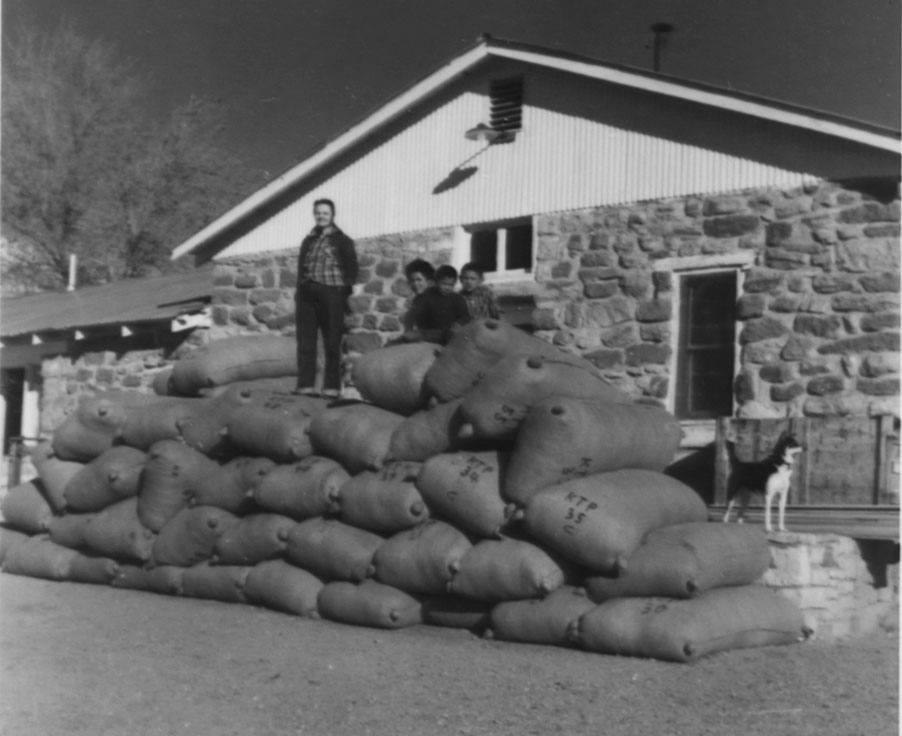
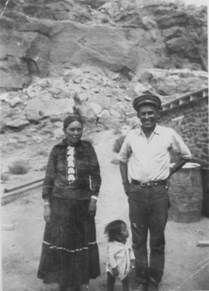
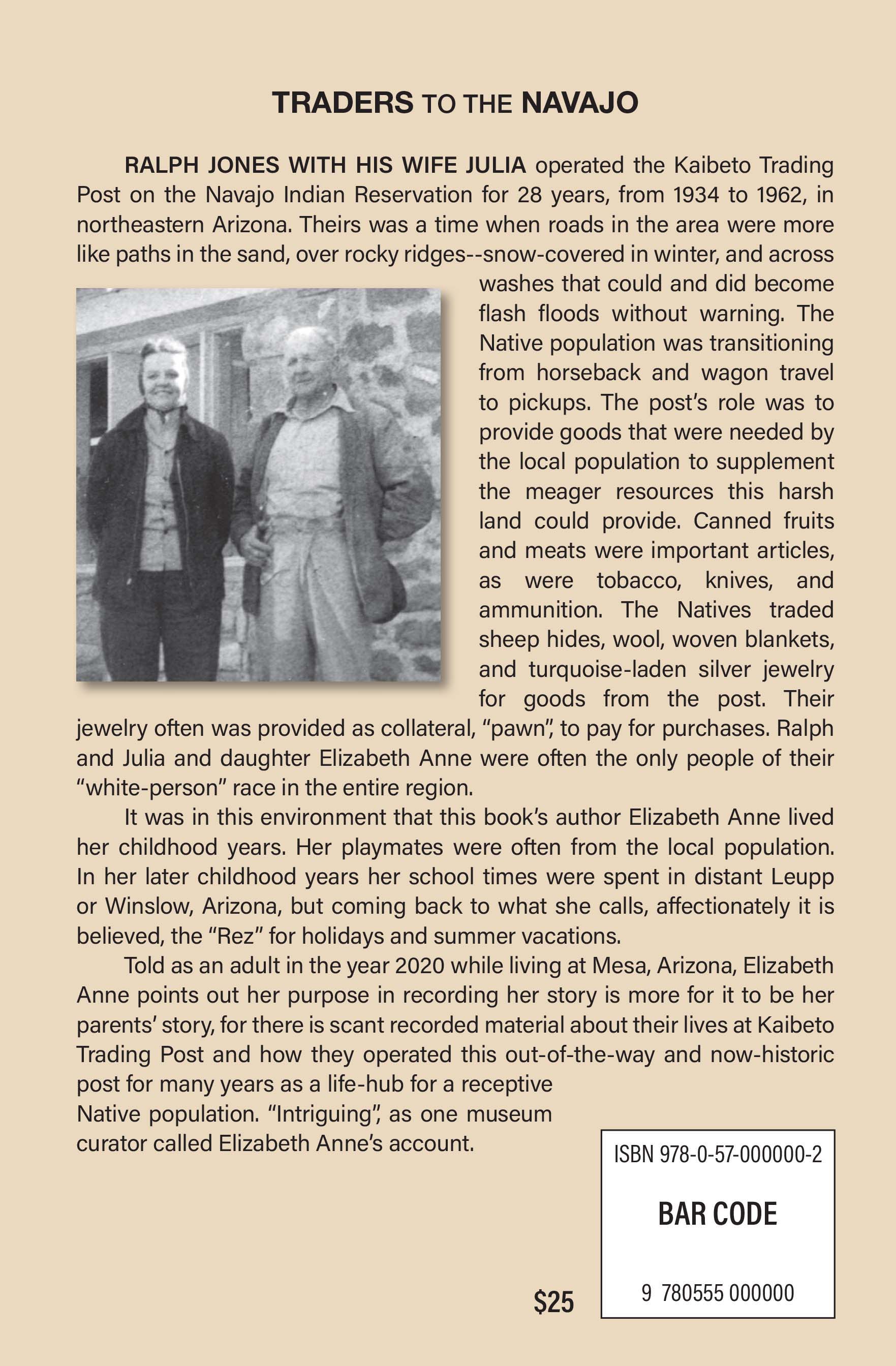 back cover
back cover
END OF "Kaibeto Memories; a trader's daughter remembers" PAGE--click for TOP
For discounts of 50-90% on related titles click VistaBooks Outlet
to Western Americana page
to Southwestern U.S. page
to Master Title List--by alpha
![]() to VistaBooks Encore Home/Contents or use links in sidebars
to VistaBooks Encore Home/Contents or use links in sidebars
This "VistaBooks Kaibeto Memories: a trader's daughter remnembers growing up on the Navajo Reservation at Kaibeto Trading Post 1936-1960" page was last modified November 30, 2023 Did you come here from a link on another website? For latest version of this page, click or copy to your browser: https://www.vistabooks.com/pages/vbe1vist0103.html. Copyright © 2023 VistaBooks LLC.
Need help? email. We want you to find what you want to find.
Thanks for looking!